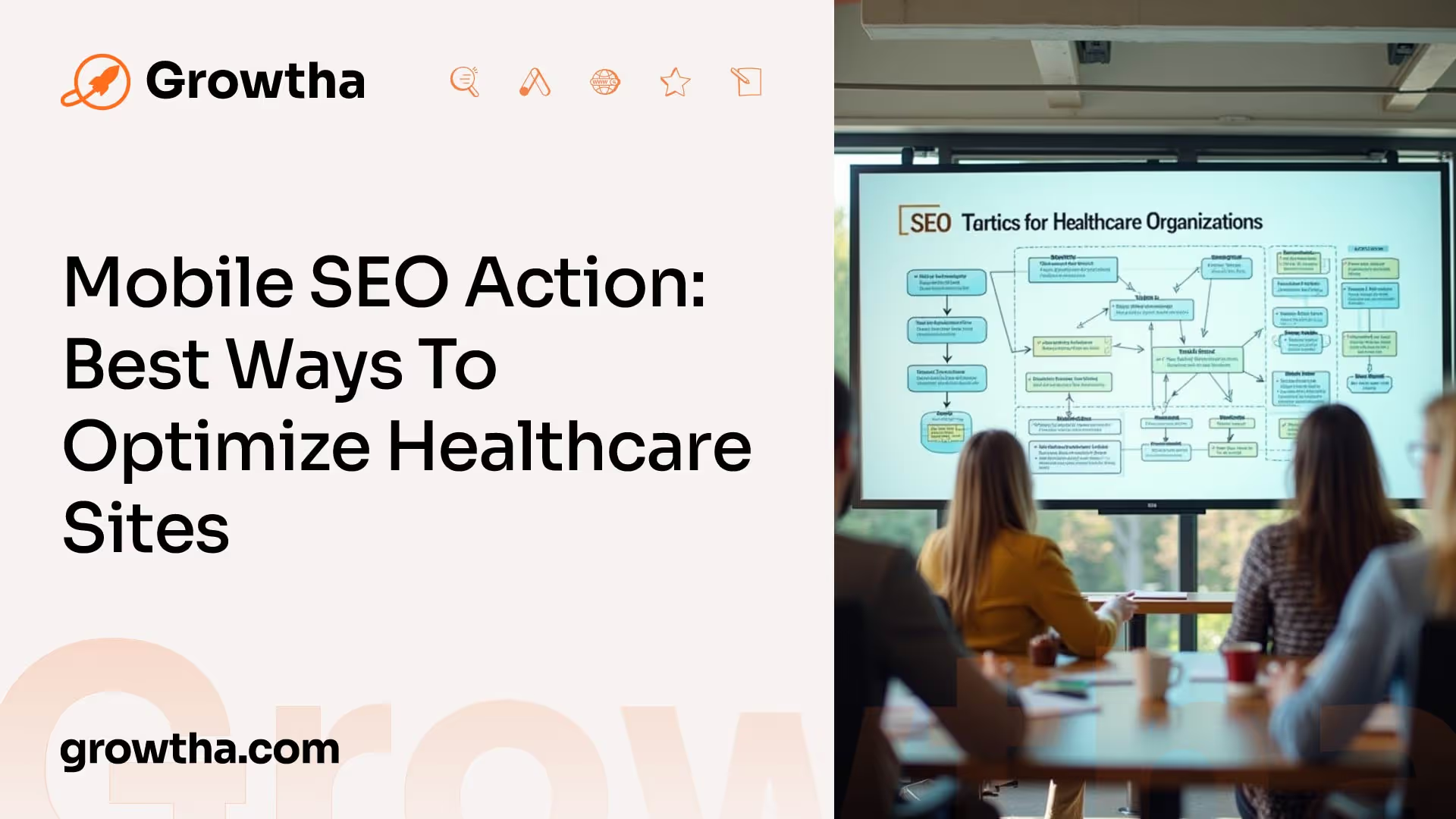Mobile SEO Action: Best Ways To Optimize Healthcare Sites
Implementing healthcare SEO strategies is essential for optimizing online visibility and driving relevant traffic to medical websites.


Mobile SEO Action: Best Ways To Optimize Healthcare Sites
Importance of Healthcare SEO

In today's digital era, healthcare organizations need to prioritize their online presence to effectively reach and engage with patients. Implementing healthcare SEO strategies is essential for optimizing online visibility and driving relevant traffic to medical websites. This section will explore the impact of online search for healthcare and the benefits of investing in healthcare SEO.
Impact of Online Search for Healthcare
Online search plays a significant role in the healthcare industry, with patients increasingly relying on search engines to find information about medical conditions, treatments, and healthcare providers. According to Google, online search drives three times as many visitors to hospital websites compared to other sources [1]. Furthermore, a study found that 80% of US adults conducted a healthcare-related search in the last year [1].
Patients turn to search engines to seek answers to their medical questions, locate healthcare facilities, and research healthcare providers. The internet has become a go-to resource for patients to educate themselves about their health and make informed decisions. Therefore, healthcare organizations that prioritize their online visibility are better positioned to attract and engage with their target audience.
Benefits of Investing in Healthcare SEO

Investing in healthcare SEO offers numerous benefits for healthcare organizations. By implementing effective SEO strategies, healthcare providers can:
- Differentiate from Competitors: In a competitive healthcare landscape, SEO allows organizations to differentiate themselves from competitors and stand out in search engine result pages (SERPs). If a competitor ranks higher in search results while your organization is buried on page two or beyond, valuable opportunities for growth may be lost.
- Grow Patient Base: With a growing number of patients relying on online search to find healthcare services, investing in healthcare SEO is crucial for attracting new patients. By optimizing website content, improving search engine rankings, and increasing online visibility, healthcare organizations can expand their patient base and connect with individuals seeking their specific services.
- Enhance Local Presence: For healthcare providers operating in specific geographic areas, local SEO is particularly important. By optimizing for local searches, healthcare organizations can increase their visibility in location-based search results. This helps target patients who are actively seeking healthcare services in their vicinity. A strong local online presence can lead to increased website traffic, patient inquiries, and appointments [2].
- Build Trust and Credibility: Implementing effective SEO strategies helps healthcare organizations establish trust and credibility with patients. By appearing prominently in search results, healthcare providers demonstrate their expertise and reliability. Positive online reviews and high search rankings contribute to a strong online reputation, further instilling confidence in potential patients.
Investing in healthcare SEO is vital to capitalize on the power of online search and effectively reach patients in today's digital landscape. By optimizing their online presence, healthcare organizations can attract, engage, and convert prospective patients, ultimately driving business growth and success.
Local SEO for Healthcare

In the realm of healthcare marketing, implementing local SEO strategies is paramount for healthcare organizations. With many patients searching for healthcare services specific to their location, optimizing your website to show up in local searches can tap into highly relevant, local searches from potential patients.
Significance of Local SEO
Local SEO holds great importance for healthcare providers, given that 46% of all Google searches are looking for local information. Incorporating local keywords into your website's content enhances visibility in local search results, making it crucial for attracting patients in nearby areas [3]. Patients often prefer nearby healthcare professionals and rely on online reviews as part of their evaluation process. By implementing a local search campaign, healthcare providers can increase their online visibility, credibility, and the effectiveness of reaching their sales targets [4]. Additionally, many healthcare providers primarily serve their local communities, and user preferences for nearby healthcare professionals are influenced by local coverage provided by insurance providers, making local SEO even more vital [4].
Optimizing for Local Searches
To optimize your healthcare website for local searches, there are several key strategies to consider:
- Local Keywords: Incorporate relevant local keywords throughout your website's content, including in page titles, headings, meta descriptions, and body text. This helps search engines understand the localized focus of your website and improves your chances of appearing in local search results.
- Location-Specific Pages: Create dedicated pages on your website that target specific geographic areas you serve. These pages should include location-specific information, such as the services offered in that area, contact details, and testimonials from patients in the local community.
- Google My Business: Claiming and optimizing your Google My Business listing is crucial for local SEO. Ensure that your listing is complete with accurate information, including your address, phone number, website, and business hours. Encourage patients to leave reviews on your Google My Business page to boost your credibility and enhance your local search presence.
- Online Directories and Review Sites: Ensure that your healthcare organization is listed accurately on popular online directories and review sites, such as Yelp, Healthgrades, and Vitals. Consistent and up-to-date information across these platforms can improve your local search rankings and reputation.
- Localized Content: Develop content that caters specifically to your local audience. This can include blog posts, articles, and videos that discuss healthcare topics relevant to your community. By addressing local health concerns and providing valuable information, you can establish yourself as a trusted resource in the local healthcare landscape.
- Local Link Building: Seek opportunities to build relationships with local businesses, organizations, and influencers. This can lead to valuable backlinks from reputable local sources, further boosting your local SEO efforts.
By implementing these local SEO strategies, healthcare organizations can increase their visibility in local search results and effectively attract patients from their immediate vicinity. It's important to continuously monitor and adapt your local SEO approach to stay ahead in the competitive healthcare marketing landscape.
Components of Healthcare SEO Strategy

To successfully optimize a healthcare website for search engines and improve its visibility, there are several key components to consider. These components include technical SEO essentials, content optimization for medical websites, and backlink building and online reputation management.
Technical SEO Essentials
Technical SEO plays a crucial role in ensuring that potential patients can quickly find the necessary information on healthcare websites, enhancing user experience, credibility, and ultimately attracting more patients [3]. Some essential technical SEO elements for healthcare websites include:
- Website Speed and Performance: Optimizing website speed to minimize page load times and improve user experience.
- Mobile-Friendliness: Ensuring the website is responsive and mobile-friendly, as mobile search continues to grow in prominence.
- Crawlability and Indexability: Ensuring search engine bots can crawl and index the website effectively.
- Structured Data Markup: Implementing structured data markup to provide search engines with additional context and improve the appearance of search results.
- Sitemap: Creating and submitting a sitemap to help search engines discover and crawl all pages of the website.
By prioritizing technical SEO elements, healthcare websites can improve their visibility in search engine results and provide a seamless user experience.
Content Optimization for Medical Websites
Content optimization is another critical component of healthcare SEO. By creating high-quality, relevant, and valuable content, healthcare providers can attract and engage potential patients. Key considerations for content optimization include:
- Keyword Research: Identifying relevant keywords and incorporating them naturally into the content to improve visibility in search engine results.
- Meta Tags: Optimizing meta titles and descriptions to improve click-through rates and provide concise information about the page.
- High-Quality Content: Creating informative and engaging content that addresses the needs and concerns of potential patients.
- Images and Videos: Including visually appealing images and videos to enhance the content and keep visitors engaged.
- Alt Text: Adding descriptive alt text to images for accessibility and search engine crawlers' understanding of the content.
By optimizing content, healthcare websites can improve their search engine rankings and provide valuable information to potential patients.
Backlink Building and Online Reputation Management

Building backlinks from high-authority websites is a significant component of healthcare SEO. Quality backlinks demonstrate a website's authority and can help boost its ranking in search engine results pages (SERPs). Additionally, managing online reputation is crucial for healthcare providers, as 72% of potential patients use online reviews to choose a healthcare provider [5]. Key strategies for backlink building and online reputation management include:
- Obtaining High-Quality Backlinks: Actively seeking backlinks from reputable sources, such as industry publications, medical associations, and authoritative websites.
- Encouraging Online Reviews: Engaging with patients and encouraging them to leave reviews on review platforms and social media.
- Google Business Profiles: Optimizing Google Business Profiles to appear in local search results and showcase positive reviews and ratings.
By building high-quality backlinks and managing online reputation, healthcare websites can improve their online presence, credibility, and attract more potential patients.
By implementing these components of healthcare SEO strategy, healthcare providers can optimize their websites for search engines, improve visibility, and effectively reach and engage potential patients.
Mobile SEO for Healthcare Websites
In today's digital age, mobile devices play a significant role in how people access information and interact with websites. For healthcare providers and marketers, optimizing their websites for mobile devices is crucial to ensure a positive user experience and improve search engine rankings. This section will explore the importance of mobile SEO and provide best practices for mobile optimization.
Understanding Mobile SEO
Mobile SEO, or Mobile Search Engine Optimization, is the process of optimizing a website to ensure it performs well and delivers a positive user experience on mobile devices. With the increasing number of users accessing the internet through smartphones and tablets, focusing on mobile optimization has become vital for overall SEO success.
Mobile SEO involves similar practices to desktop SEO but with a specific focus on mobile devices. It aims to make the website easily accessible and visually appealing on smaller screens, improving user engagement and satisfaction. By implementing mobile SEO strategies, healthcare websites can enhance their visibility in mobile search results and cater to the growing number of mobile users in the healthcare industry.
Best Practices for Mobile Optimization
To effectively optimize healthcare websites for mobile devices, it's important to follow best practices that enhance the user experience and align with search engine guidelines. Here are some key practices to consider:
- Responsive Design: Implement a responsive web design that automatically adjusts the layout and content based on the user's device. This ensures a consistent and user-friendly experience across different screen sizes.
- Fast Loading Speed: Optimize the website's loading speed for mobile devices. Users expect quick access to information, and a slow-loading website can lead to frustration and high bounce rates. Compress images, minify code, and leverage browser caching to improve loading times.
- Mobile-Friendly Navigation: Simplify navigation menus and ensure they are easy to use on smaller screens. Use clear and concise labels, and consider implementing a hamburger menu for better mobile navigation.
- Readable Typography: Choose fonts that are legible on mobile devices, considering factors like font size and line spacing. Avoid small font sizes and excessive use of decorative fonts that may be difficult to read on smaller screens.
- Optimized Content: Ensure that the content on the website is optimized for mobile viewing. Use shorter paragraphs, bullet points, and headings to break up text and make it easier to scan. Optimize images for mobile devices by compressing them without sacrificing quality.
- Mobile-Friendly Forms: If your healthcare website includes forms for appointments or inquiries, make sure they are mobile-friendly. Use appropriate input fields, minimize the number of required fields, and optimize the form layout for mobile screens.
By following these best practices, healthcare websites can enhance the mobile user experience, improve search engine visibility, and ultimately connect with their target audience more effectively.
In summary, mobile SEO is essential for healthcare websites due to the increasing number of users accessing the internet via mobile devices. Optimizing websites for mobile ensures a positive user experience, improves search engine rankings, and helps healthcare providers and marketers effectively reach their target audience. By understanding mobile SEO and implementing best practices, healthcare organizations can revolutionize their marketing efforts and stay ahead in the digital landscape.
Patient-Centric Approach to Medical SEO
In the world of healthcare SEO, it is crucial to adopt a patient-centric approach to ensure that your website effectively meets the needs and expectations of your target audience. By understanding patient behavior and implementing strategies to improve user experience, you can enhance your healthcare SEO efforts.
Patient Behavior and Search
Patients are increasingly turning to the internet to search for healthcare information, providers, and services. According to Siteimprove, a great healthcare SEO strategy can attract new patients, but providing an outstanding digital experience is important for retaining them. Search engines also consider the quality of website experience in their ranking considerations.
To effectively optimize your medical website for patient-centric SEO, it is essential to understand patient behavior and search patterns. Conducting thorough keyword research will enable you to identify the specific terms and phrases that patients commonly use when searching for healthcare information. By incorporating these keywords strategically throughout your website content, you can improve your visibility in search engine results.
Additionally, understanding patient search intent is crucial. Patients may search for general health information, specific medical conditions, treatment options, or healthcare providers in their area. By tailoring your content to address these specific search intents, you can attract and engage the right audience.
Strategies for Improving User Experience
Improving user experience is a key aspect of a patient-centric medical SEO strategy. When it comes to mobile SEO, it is important to recognize that mobile sites have different requirements and user expectations compared to desktop websites. As mentioned by UX Matters, mobile sites typically focus on crucial functions and features that are relevant to time and location.
To optimize your medical website for mobile users, consider the following strategies:
- Mobile-Friendly Design: Ensure that your website is well-designed and works seamlessly on tablets and smartphones. A responsive design that automatically adjusts to different screen sizes is essential for providing a positive user experience [6].
- Fast Loading Speed: Mobile users expect websites to load quickly. Optimize your website's loading speed by compressing images, minimizing server requests, and leveraging browser caching. A fast-loading website improves user satisfaction and reduces bounce rates.
- Clear and Concise Content: Mobile users have limited screen space, so it's important to present information in a clear and concise manner. Use headings, bullet points, and short paragraphs to make your content scannable and easy to read.
- Mobile-Friendly Navigation: Simplify navigation for mobile users by using a clear and intuitive menu structure. Ensure that buttons and links are large enough to be easily tapped with a finger.
By implementing these strategies, you can enhance the user experience for patients accessing your website on mobile devices. This positive experience will encourage users to stay on your website, interact with your content, and potentially convert into patients.
Remember, a patient-centric approach to medical SEO involves continuously monitoring and optimizing your website based on patient feedback and behavior. Regularly analyzing user data and making improvements accordingly will help you stay ahead in the ever-evolving world of healthcare SEO.
Healthcare SEO Implementation and Timeline
Implementing an effective healthcare SEO strategy requires a systematic approach and a comprehensive understanding of the factors involved in optimizing medical websites for search engines. Let's explore the execution of medical SEO and the expected results and timeframe associated with this process.
Execution of Medical SEO
Medical SEO is a complex algorithm-driven process that involves various components, including keyword research, content optimization, technical SEO, local SEO, content marketing, backlink building, user experience, and compliance. It aims to improve the visibility of medical websites in search engine results pages (SERPs), allowing healthcare providers to connect with potential patients who are actively searching for healthcare services.
To execute a successful medical SEO strategy, healthcare marketers and professionals need to conduct thorough keyword research to identify relevant and high-value keywords related to their services. This research helps in optimizing website content, meta tags, headings, and other on-page elements to align with the search intent of potential patients.
Technical SEO plays a vital role in ensuring that the medical website is properly structured and optimized for search engine crawlers. This includes optimizing website speed, security, mobile-friendliness, and implementing structured data markup to enhance visibility in search results [7].
Local SEO is particularly important for healthcare providers as the majority of patients turn to search engines like Google, which captures 96% of search traffic, when looking for healthcare services. Optimizing for local searches involves claiming and optimizing Google My Business listings, obtaining positive patient reviews, and ensuring consistent NAP (name, address, phone number) information across online directories.
Content marketing and backlink building are essential components of a medical SEO strategy. Creating informative and engaging content that addresses patients' needs and concerns helps in establishing the healthcare provider's expertise and authority. Building high-quality backlinks from reputable sources improves the website's credibility and visibility in search results.
Expected Results and Timeframe
It's important to understand that medical SEO is a long-term strategy that requires patience and consistent effort. The expected results and timeframe for medical SEO can vary depending on various factors, including the competition in the healthcare industry and the specific target keywords.
Typically, the initial results of medical SEO efforts start to appear within 4 to 12 months [7]. However, it's important to note that achieving higher rankings and sustained visibility in search results requires ongoing optimization and maintenance. Staying up to date with algorithm changes and adjusting the SEO strategy accordingly is crucial for long-term success.
The ultimate goal of medical SEO is to improve the website's visibility, attract relevant organic traffic, and convert potential patients into actual patients. While there is no fixed timeline for achieving specific rankings, consistent implementation of best practices and continuous monitoring of the website's performance can lead to significant improvements in organic search visibility and patient acquisition.
By executing a well-planned medical SEO strategy and understanding the expected results and timeframe, healthcare providers can effectively revolutionize their healthcare marketing and reach patients in need of their services.
References
[1]: https://www.siteimprove.com/glossary/healthcare-seo/
[2]: https://www.demandhub.co/articles/doctor-seo/
[3]: https://www.linkedin.com/pulse/3-core-components-strong-healthcare-seo-strategy-digitalismedical
[4]: https://surferseo.com/blog/healthcare-seo/
[5]: https://www.demandhub.co/articles/healthcare-seo/







